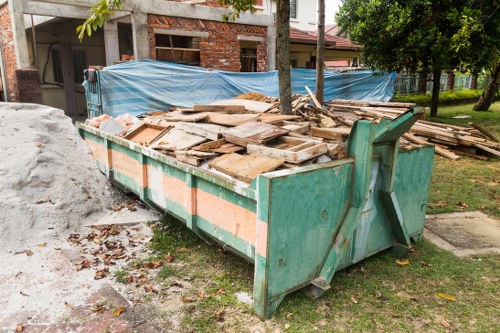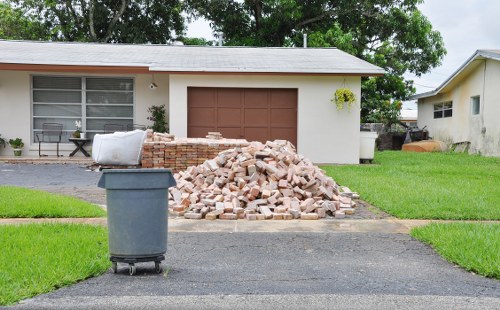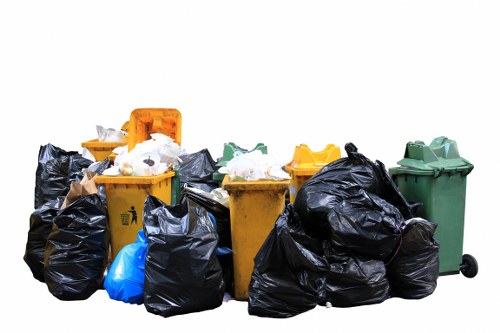Construction Waste Clearance in Swiss Cottage

Construction projects, whether large or small, inevitably generate considerable amounts of waste. Proper clearance and disposal of this waste are crucial not only for maintaining a clean and safe environment but also for complying with local regulations. In Swiss Cottage, a bustling area known for its vibrant community and ongoing development, effective construction waste clearance is essential.
Swiss Cottage has seen significant growth in recent years, with numerous residential and commercial projects underway. This growth brings with it challenges related to waste management. Without efficient clearance systems in place, construction waste can lead to environmental degradation, health hazards, and legal issues.
Addressing these challenges requires a comprehensive approach to waste management. By engaging with professional construction waste clearance services in Swiss Cottage, project managers can ensure that waste is handled responsibly and sustainably.
Understanding Construction Waste Clearance

Construction waste clearance involves the removal and disposal of debris generated during construction, renovation, or demolition activities. This includes materials such as concrete, wood, metals, plastics, and hazardous substances. Proper management of these materials is vital for minimizing environmental impact and ensuring the safety of workers and the surrounding community.
There are various types of construction waste, each requiring specific handling and disposal methods. Categorizing and sorting waste appropriately can facilitate recycling and reduce the amount of material sent to landfills.
Professional waste clearance companies offer comprehensive services, including collection, sorting, recycling, and disposal. They are equipped to handle different types of waste efficiently, adhering to regulatory standards and best practices.
Types of Construction Waste

Understanding the different types of construction waste is the first step in effective waste clearance. The primary categories include:
- Concrete and Masonry: These materials are heavy and require specialized disposal methods.
- Wood and Timber: Often recyclable and can be repurposed for other projects.
- Metals: Recyclable and valuable, metals should be separated from other waste.
- Plastics and Insulation: Must be handled carefully to avoid contamination and environmental harm.
- Hazardous Materials: Includes asbestos, lead, and other substances that require safe removal and disposal.
By categorizing waste types, clearance services can streamline the recycling process and ensure that hazardous materials are dealt with appropriately.
Effective waste management not only complies with local regulations but also promotes sustainability by reducing the environmental footprint of construction projects.
The Importance of Professional Waste Clearance

Engaging professional construction waste clearance services offers numerous benefits. Firstly, it ensures compliance with local laws and regulations, which can vary in Swiss Cottage. Non-compliance can result in hefty fines and project delays.
Secondly, professional services bring expertise and equipment necessary for efficient waste management. From heavy-duty trucks to recycling facilities, they have the resources to handle waste of all types and volumes.
Additionally, professional clearance services contribute to a cleaner and safer construction site. By promptly removing debris, they reduce the risk of accidents and create a more organized working environment.
Benefits of Timely Waste Clearance

Timely waste clearance has several advantages:
- Enhanced Safety: Reduces tripping hazards and prevents accidents on site.
- Improved Efficiency: Frees up space, allowing construction activities to proceed without obstruction.
- Environmental Protection: Minimizes pollution and promotes recycling and reuse of materials.
- Regulatory Compliance: Ensures all waste is disposed of according to local laws, avoiding fines.
- Cost Savings: Prevents unnecessary expenses related to fines, delays, and inefficient waste handling.
By prioritizing waste clearance, construction projects can achieve higher standards of safety, efficiency, and sustainability.
Moreover, maintaining a clean site enhances the overall image of the project and the responsible nature of the developers.
Choosing the Right Waste Clearance Service

Selecting the appropriate construction waste clearance service in Swiss Cottage involves several considerations. Firstly, assess the company's experience and reputation in the industry. Established companies with a track record of successful projects are preferable.
Secondly, ensure that the service provider is licensed and insured. This protects you from potential liabilities and guarantees that the company adheres to industry standards.
Additionally, evaluate the range of services offered. Comprehensive services that include sorting, recycling, and disposal are ideal as they provide a one-stop solution for all your waste management needs.
Evaluating Service Providers

When evaluating potential waste clearance providers, consider the following factors:
- Experience: Years in the industry and expertise in handling different types of construction waste.
- Certifications: Relevant certifications indicating adherence to environmental and safety standards.
- Equipment: Modern and well-maintained equipment for efficient waste removal.
- Customer Reviews: Feedback from previous clients to gauge service quality and reliability.
- Flexibility: Ability to accommodate your project’s specific needs and timelines.
By carefully evaluating these aspects, you can select a provider that best fits your project requirements and ensures effective waste clearance.
Moreover, open communication and transparency in pricing are essential for a smooth working relationship.
Environmental Impact of Construction Waste

The environmental impact of construction waste can be significant if not managed properly. Landfills are rapidly filling up, and improper disposal contributes to pollution and resource depletion. By prioritizing waste clearance in Swiss Cottage, construction projects can mitigate these adverse effects.
Recycling construction waste reduces the demand for new raw materials, conserving natural resources and minimizing energy consumption. It also lowers greenhouse gas emissions associated with producing and transporting new materials.
Furthermore, responsible waste management practices enhance the sustainability of construction projects, aligning them with broader environmental goals and community expectations.
Recycling and Reuse

Recycling and reusing construction waste is a crucial aspect of sustainable construction. Materials such as metal, wood, and concrete can be recycled and used in new projects, reducing the need for virgin resources.
Many waste clearance services offer recycling programs, ensuring that recyclable materials are properly sorted and processed. This not only reduces the volume of waste sent to landfills but also contributes to a circular economy.
Incorporating recycled materials into construction projects can also lead to cost savings and innovative design solutions, promoting both economic and environmental benefits.
Regulations and Compliance

Compliance with local regulations is a critical aspect of construction waste clearance. Swiss Cottage has specific guidelines governing waste disposal, recycling mandates, and environmental protection standards.
Failure to comply with these regulations can result in legal repercussions, including fines and project delays. Therefore, it is essential to stay informed about the latest regulations and work with a waste clearance service that ensures adherence.
Professional waste clearance providers are well-versed in local laws and can navigate the complexities of regulatory compliance, ensuring that your project complies with all necessary standards.
Permit Requirements

Obtaining the necessary permits for waste disposal is another important aspect of compliance. Permits ensure that waste is managed in a manner that protects public health and the environment.
- Waste Disposal Permits: Required for the legal disposal of construction waste.
- Recycling Permits: Needed for specific recycling activities and processing.
- Transport Permits: Necessary for the movement of waste materials to disposal or recycling facilities.
Working with a professional waste clearance service ensures that all permit requirements are met, simplifying the process and avoiding potential legal issues.
Moreover, a reputable provider can handle the paperwork and liaise with regulatory bodies on your behalf.
Cost Factors in Waste Clearance

Understanding the cost factors associated with construction waste clearance in Swiss Cottage is essential for budgeting your project effectively. Several elements influence the overall cost, including the volume of waste, type of materials, and specific services required.
Additional costs may be incurred for the removal of hazardous materials, expedited services, or specialized handling. It is important to obtain detailed quotes from service providers, ensuring transparency in pricing and avoiding unexpected expenses.
Investing in professional waste clearance can lead to long-term savings by preventing potential fines, reducing material costs through recycling, and enhancing project efficiency.
Budgeting for Waste Clearance

When budgeting for waste clearance, consider the following:
- Volume of Waste: Larger projects generate more waste, increasing disposal costs.
- Type of Waste: Hazardous or non-recyclable materials may incur higher fees.
- Service Frequency: Regular pickups can reduce the need for large, infrequent disposals.
- Recycling Services: Recycling may involve additional costs but offers long-term benefits.
- Geographical Location: Proximity to disposal or recycling facilities can affect transportation costs.
By planning and estimating these factors, you can allocate your budget more accurately and select a waste clearance service that fits your financial constraints.
Additionally, negotiating contracts with clear terms can help control costs and ensure that services are delivered as agreed.
Best Practices for Waste Management

Implementing best practices in construction waste management enhances both efficiency and sustainability. Here are some key strategies:
- Plan Ahead: Integrate waste management into the project plan from the outset.
- Sort and Segregate: Separate different types of waste for easier recycling and disposal.
- Minimize Waste: Optimize construction processes to reduce the generation of waste.
- Engage Professionals: Partner with experienced waste clearance services for expert handling.
- Monitor and Review: Continuously assess waste management practices and make improvements.
Adhering to these best practices not only ensures compliance and efficiency but also promotes a culture of sustainability within the construction industry.
Furthermore, effective waste management can lead to innovative solutions and cost savings, benefiting both the environment and your project’s bottom line.
Sustainable Construction Practices

Sustainability in construction goes hand-in-hand with effective waste management. By reducing, reusing, and recycling materials, projects can significantly lower their environmental impact.
Implementing green building practices, such as using recycled materials and energy-efficient processes, further enhances the sustainability of construction projects.
Collaborating with waste clearance services that prioritize sustainability ensures that your project aligns with eco-friendly standards and contributes positively to the community.
Technology in Waste Clearance

Advancements in technology have revolutionized construction waste clearance, making the process more efficient and environmentally friendly. Technologies such as waste tracking systems, automated sorting, and data analytics enable better management and optimization of waste processes.
Some companies now use GPS tracking to streamline waste collection routes, reducing fuel consumption and emissions. Automated sorting machines can quickly and accurately separate recyclable materials from non-recyclable waste, enhancing recycling rates.
Data analytics provide insights into waste generation patterns, helping project managers make informed decisions to minimize waste production and improve overall waste management strategies.
Innovative Waste Solutions

Innovative solutions, such as on-site recycling facilities and waste-to-energy technologies, are transforming the landscape of construction waste clearance. These solutions not only reduce the need for transportation and disposal but also create valuable resources from waste materials.
On-site recycling allows for immediate processing and reuse of materials, saving time and reducing environmental impact. Waste-to-energy facilities convert non-recyclable waste into usable energy, providing a sustainable alternative to traditional disposal methods.
Adopting these innovative approaches can significantly enhance the sustainability and efficiency of construction projects, setting new standards in waste management.
Case Studies: Successful Waste Clearance Projects

Examining successful waste clearance projects in Swiss Cottage provides valuable insights into best practices and effective strategies. These case studies highlight the importance of meticulous planning, professional services, and innovative solutions in achieving optimal waste management outcomes.
One notable project involved the redevelopment of a residential complex, where a comprehensive waste clearance plan was implemented. By collaborating with a professional waste clearance service, the project achieved a high recycling rate and minimized its environmental footprint.
Another example includes the construction of a commercial building, where on-site recycling facilities were used to process waste materials efficiently. This approach not only reduced disposal costs but also promoted sustainability within the project.
Lessons Learned

These case studies emphasize several key lessons:
- Early Planning: Integrating waste management into the project plan from the beginning ensures better outcomes.
- Professional Partnership: Working with experienced waste clearance services enhances efficiency and compliance.
- Innovative Approaches: Utilizing advanced technologies and sustainable practices leads to superior waste management.
- Continuous Improvement: Regularly reviewing and refining waste management strategies fosters ongoing improvement.
- Community Engagement: Involving the community and stakeholders promotes transparency and responsibility.
Applying these lessons to future projects can lead to more effective and sustainable waste clearance practices, benefiting both the environment and the construction industry.
This continuous learning and adaptation are essential for advancing construction waste management standards in Swiss Cottage and beyond.
Future Trends in Waste Clearance

The field of construction waste clearance is evolving, with several trends shaping its future. Emphasis on sustainability, technological advancements, and stricter regulations are driving changes in how waste is managed in Swiss Cottage.
One emerging trend is the integration of circular economy principles, focusing on the reuse and recycling of materials to create closed-loop systems. This approach minimizes waste generation and enhances resource efficiency.
Another trend is the adoption of smart waste management systems that leverage IoT devices and data analytics to optimize waste collection and processing. These systems provide real-time monitoring and enable proactive waste management strategies.
Environmental Sustainability

Environmental sustainability continues to be a driving force in the evolution of waste clearance practices. The construction industry is increasingly adopting green building standards, which emphasize the reduction of environmental impact through effective waste management.
Projects are now designed with sustainability in mind, incorporating materials that are recyclable, reusable, and have a lower environmental footprint. This shift towards sustainable construction practices ensures that waste clearance aligns with broader environmental goals.
Additionally, sustainability initiatives encourage the development and use of eco-friendly materials and processes, further reducing the environmental impact of construction projects.
Conclusion

Effective construction waste clearance in Swiss Cottage is essential for the success and sustainability of construction projects. By engaging professional waste clearance services, project managers can ensure compliance with regulations, promote environmental sustainability, and enhance the safety and efficiency of construction sites.
Understanding the types of construction waste, the importance of timely clearance, and the benefits of recycling and reuse are key components of a robust waste management strategy. Additionally, staying informed about regulatory requirements and embracing technological advancements can further optimize waste clearance processes.
As Swiss Cottage continues to develop and grow, the role of effective waste management becomes increasingly important. By prioritizing waste clearance and adopting best practices, the construction industry can contribute to a cleaner, safer, and more sustainable community.
Contact us today to learn more about our construction waste clearance services in Swiss Cottage and take the first step towards a more sustainable construction project.
Book your service now and ensure your project adheres to the highest standards of waste management and environmental responsibility.